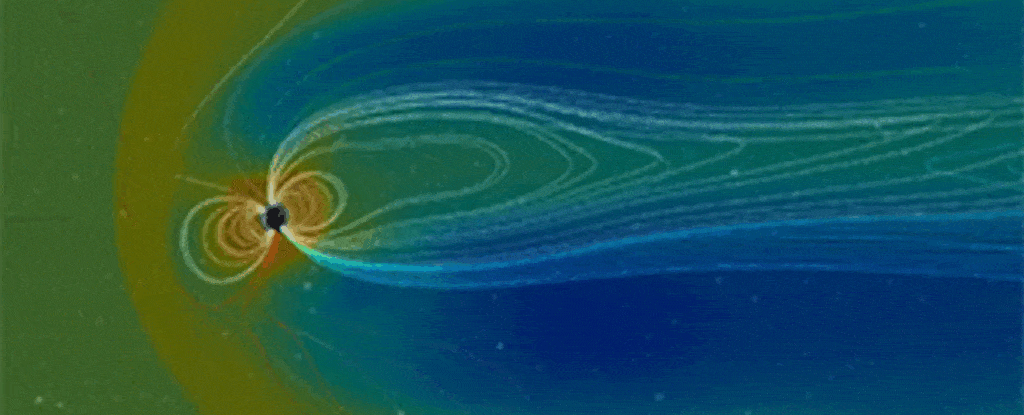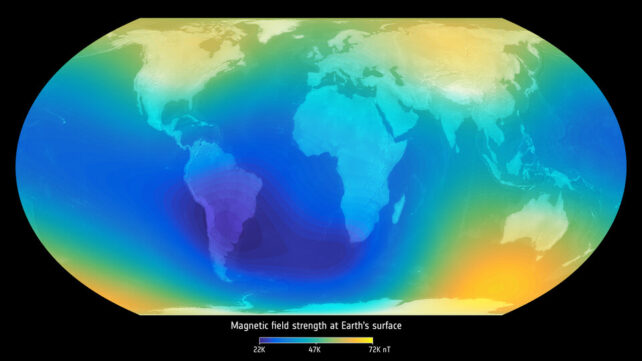Imagine standing on Earth as its magnetic field suddenly flips, unleashing a dramatic transformation in our planet’s environment. This might sound like science fiction, but a dramatic magnetic event, known as the Laschamps excursion, happened about 41,000 years ago, and the evidence is still reverberating today—through sound. Scientists have recently recreated the sounds of this ancient event, offering a haunting auditory experience that mimics the upheaval of Earth’s magnetic forces.
A Catastrophic Reversal
The Laschamps excursion, one of Earth’s most significant geomagnetic events, took place around 41,000 years ago, leaving behind an indelible mark on the planet’s magnetic field. For roughly 2,000 years, the Earth’s magnetic field weakened to just 10% of its usual strength. During this period, the magnetic poles wandered unpredictably, and for about 300 years, the magnetic field displayed behavior akin to the multipolar magnetic fields found on outer planets.
This drastic shift had serious consequences for Earth. With the magnetic field weakened, high-energy particles from the Sun were able to penetrate deeper into the atmosphere, significantly raising radiation levels and disrupting the natural balance of the environment. The change was so profound that it left traces in ancient lava flows and marine sediments, providing a direct record of this extreme event.

Sounds of the Past: A New Dimension of History
What makes this study unique is that scientists were able to recreate the sounds of the Laschamps excursion, providing a new way to experience this catastrophic event. The data, gathered from the European Space Agency’s Swarm satellite mission, was combined with physical evidence from Earth’s surface. Researchers at the Technical University of Denmark and the German Research Center for Geosciences used this information to craft a soundscape that eerily echoes the chaotic changes Earth went through during this time.
The sounds, released in 2024, resemble the creaking of wood or the collision of rocks—auditory representations of the massive forces at play in Earth’s core. These sounds not only serve as a fascinating record of the past, but they also serve as a stark reminder of Earth’s vulnerability to cosmic forces. Understanding these events is vital, not only for understanding the past, but also for predicting future shifts in Earth’s magnetic field.
The Laschamps Event and Its Impact on Life
The Laschamps excursion was not just a geological event; it profoundly affected life on Earth. As radiation levels increased due to the weakening magnetic field, living organisms faced new challenges. For humans, this period may have played a key role in the evolution of early Homo sapiens. Archaeological evidence suggests that humans began wearing tailored clothing made from animal hides—likely in response to the increased exposure to solar radiation.
At the same time, the Neanderthals, who lived alongside early humans, showed no such adaptive behaviors. Archaeologists suggest that their inability to protect themselves from the heightened radiation could have contributed to their eventual extinction. In contrast, Homo sapiens adapted by using tools for fitted clothing and perhaps using ochre as a primitive form of sunscreen, showing early signs of technological and behavioral evolution.


Understanding Today’s Magnetic Field
In the present day, scientists are still trying to understand the complexities of Earth’s magnetic field. Researchers have observed anomalies, such as the South Atlantic Anomaly, where the magnetic field is weaker than usual, exposing satellites to higher levels of radiation. This anomaly has led to concerns about the possibility of a geomagnetic reversal in the near future, although experts say these anomalies don’t directly indicate that a flip is imminent.
What makes the Laschamps excursion particularly relevant today is the potential impact on modern technology. If Earth’s magnetic field were to weaken or flip again, the consequences would be severe. Satellites, power grids, and communication systems could all face significant disruptions. Higher radiation levels would also pose a risk to air travel, particularly at higher altitudes. The experience of past geomagnetic events underscores the importance of understanding and preparing for future fluctuations in Earth’s magnetic field.

